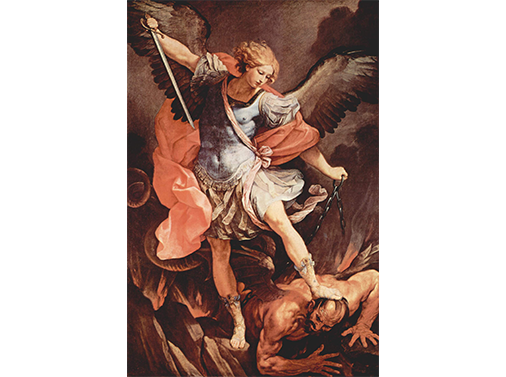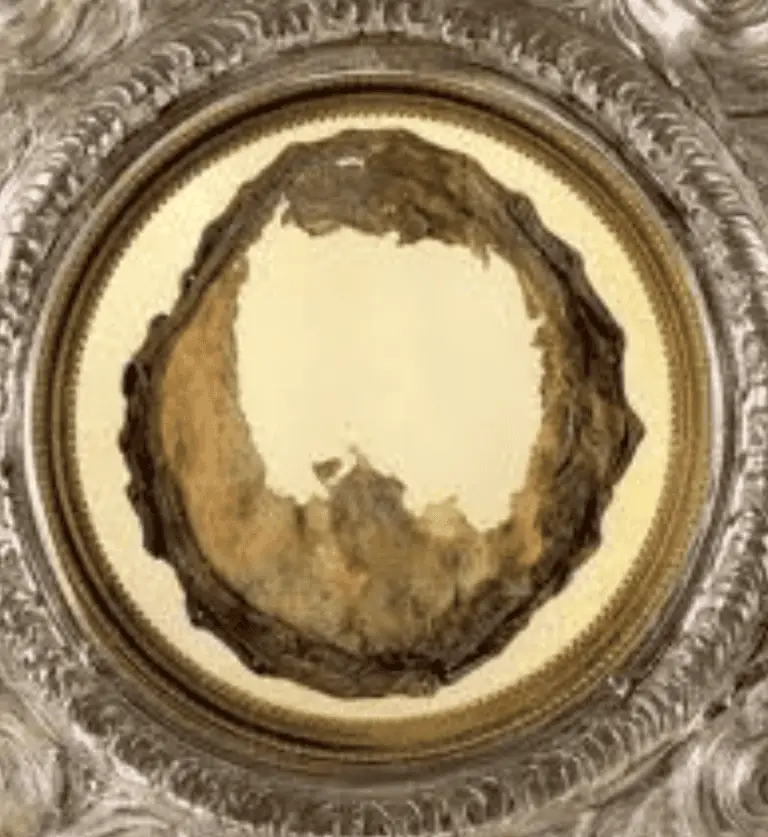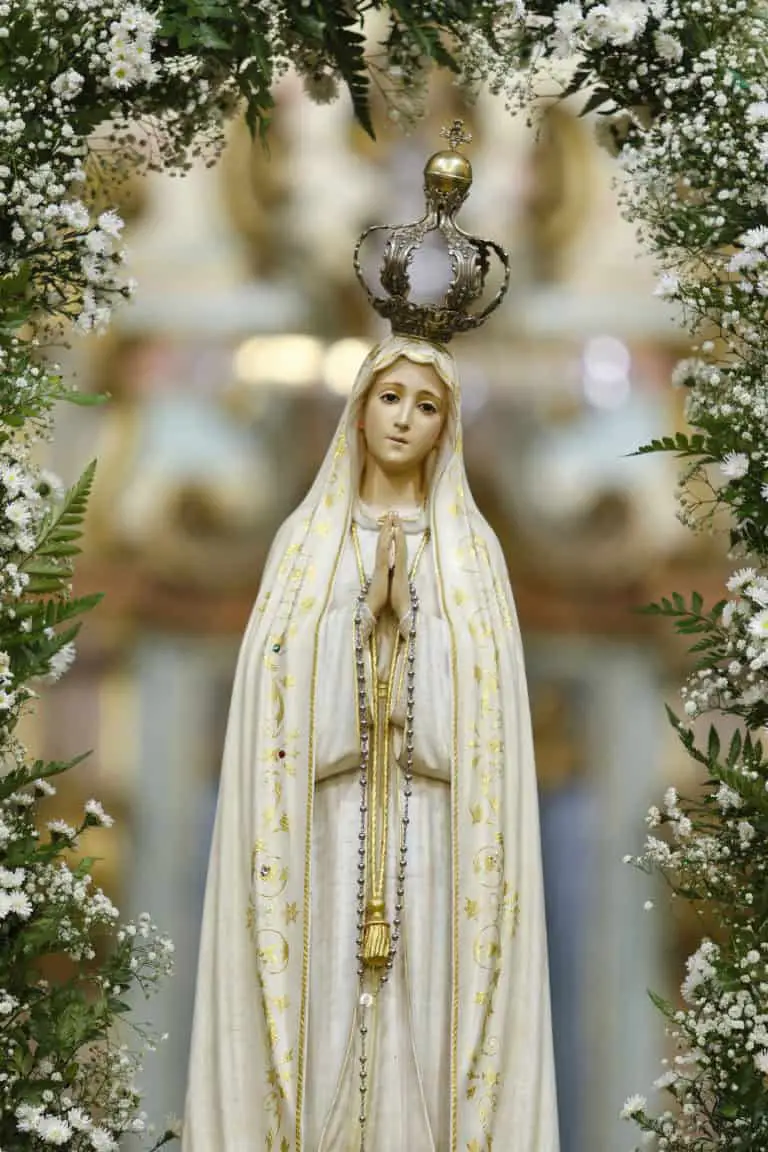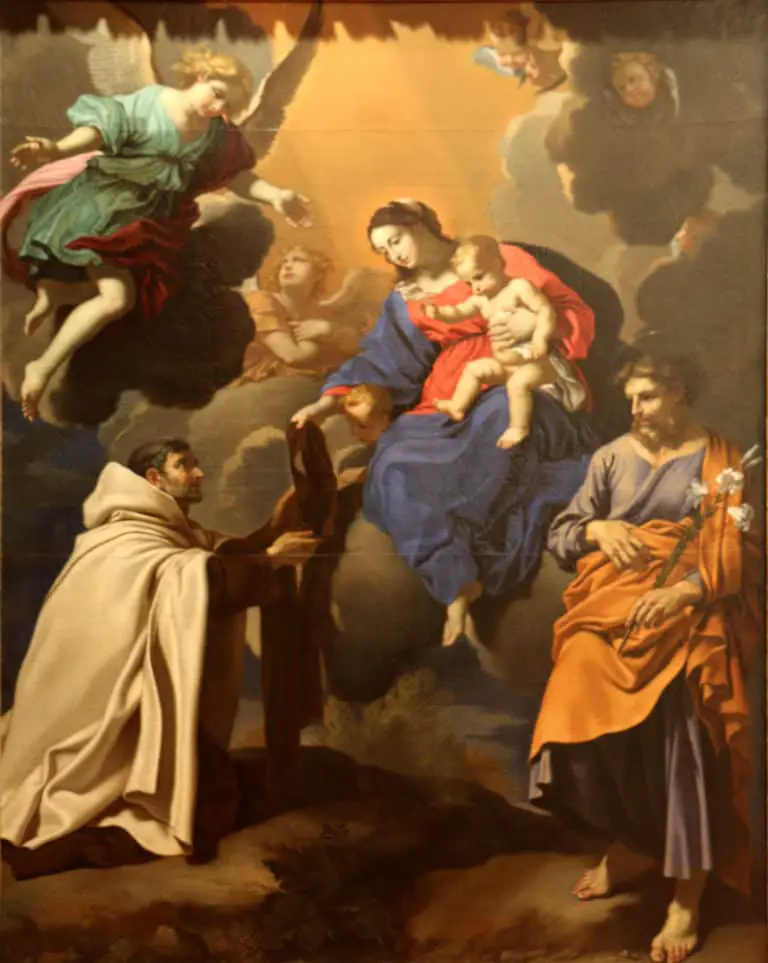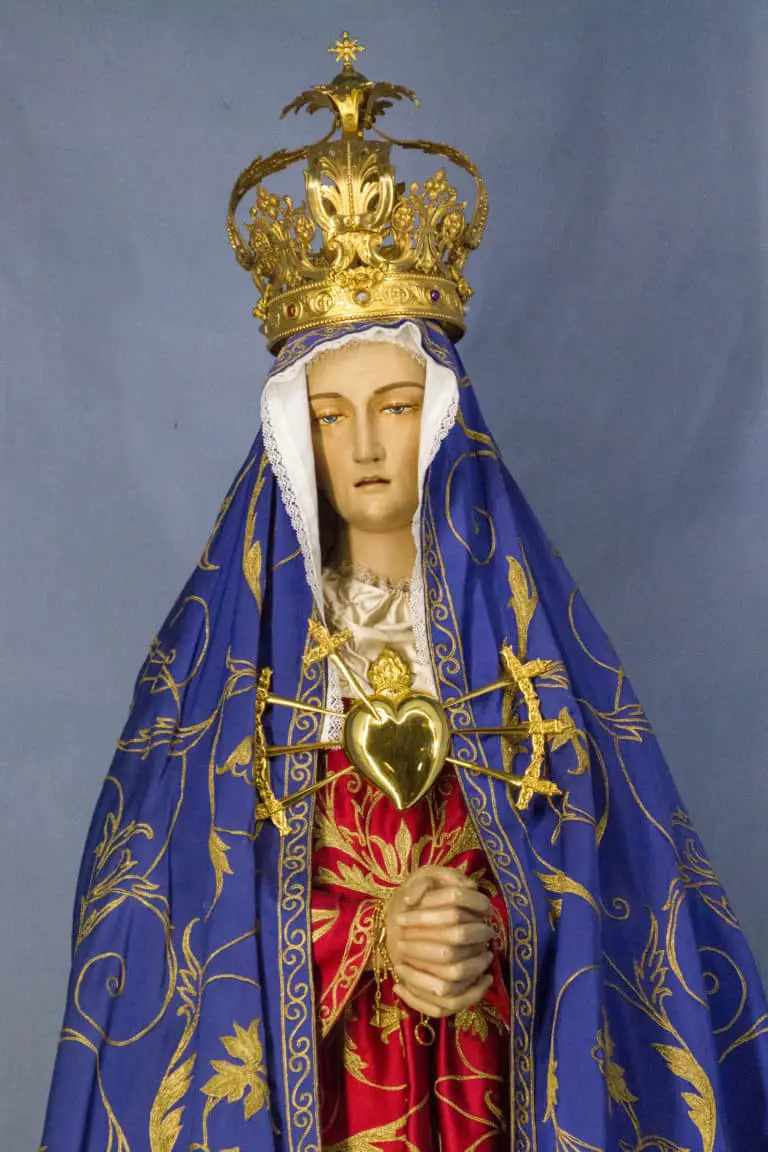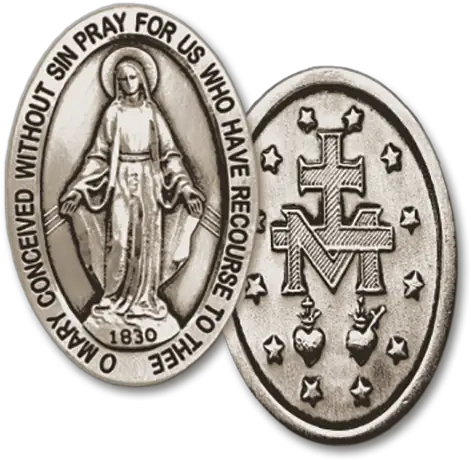What is the meaning of the St Benedict Medal?
The origin of the St Benedict Medal is virtually unknown until a discovery of a manuscript that dates to the 15th Century. The current medal design commemorates the 1440th birthday of Benedict in 1880.
The St Benedict Medal meaning was virtually unknown until the discovery of the manuscript in the 17th Century that dates to the 14th Century. The medal is filled with symbolism, events in the life of St Benedict and as a sacramental that wards off the forces of evil. A special blessing must be attached to wearing the St Benedict Medal.
What is the difference between a Sacrament and a Sacramental?
The clear definition is the Sacraments were Divinely instituted by Our Lord and Saviour, Jesus Christ and are revealed in Scripture.
The Sacramentals are instituted by the Catholic Church.
In “Thein, J. (1900). In Ecclesiastical Dictionary: Containing, in Concise Form, Information upon Ecclesiastical, Biblical, Archæological, and Historical Subjects (p. 618) the Sacraments and Sacramentals are defined:
“The sacraments were instituted by our Lord, and communicate infallibly the supernatural gift of divine grace, if their efficacy be not hindered by any evil disposition in the soul;
… the sacramentals were instituted by the Church, and remit venial sins, not in themselves, but by reason of the pious dispositions they excite, namely: increased movements of fear and love of God, of detestation of sin, and other elevations of the heart to God.
The principal sacramentals, enumerated by devout writers, are:
- The repeating of the Lord’s Prayer, or
- of the Confiteor, especially in conjunction with the priest at holy Mass;
- the blessing given by the bishop or priest, more particularly at the altar;
- the Benediction given with the holy sacrament;
- blessed bread;
- the kiss of peace;
- the pious use of various objects blessed by the Church, such as holy water, the crucifix, etc.; or
- good works executed in the name of the Church, such as teaching the Catechism to the ignorant, contributing toward the propagation of the Gospel, etc.
It should be fully understood that sacramentals do not remit venial sins by any power given them by God, over and above the good dispositions with which they are used; but either by the suffrages of the Church, or by the effect of the devout prayers of those who use them, they draw down upon the soul the remission of venial sin and of temporal punishment due for such sin. The sacramentals have a special efficacy from the blessing of prayer, through which, for example, when a person takes holy water, accompanying the outward act with the desire that God may cleanse the heart, the prayer of the Church becomes joined to his own”.
What is a Sacramental?
A Sacramental are:
“Rites possessing some outward resemblance to the sacraments, and which, though not of divine institution, are initiated or approved by the Church.” Thein, J. (1900). In Ecclesiastical Dictionary: Containing, in Concise Form, Information upon Ecclesiastical, Biblical, Archæological, and Historical Subjects (p. 618). Benziger Brothers.
The Catholic Church defines sacramentals as:
“Holy Mother Church has, moreover, instituted sacramentals. These are sacred signs which bear a resemblance to the sacraments. They signify effects, particularly of a spiritual nature, which are obtained through the intercession of the Church. By them men are disposed to receive the chief effect of the sacraments, and various occasions in life are rendered holy.” (Catechism of the Catholic Church paragraph 1667)
However, Sacramentals do not have the same grace as received through the Sacraments of Baptism, Reconciliation, Holy Communion, Confirmation, etc. But the predispose and prepare us in receiving these Sacraments and the Graces associated with them. (CCC1670).The Catholic Church gives the faithful, through approved Sacramentals or objects and that with the associated prayers and blessings of the Church, certain benefits for the person.
What are some examples of Sacramentals?
The Catholic Church has assigned certain blessed items, objects, actions and exorcism that carry with them spiritual assistance in the life of the person who wears or applies them devoutly.
Here is a list of 13 popular Sacramentals:
- The Holy Rosary.
- The Scapular.
- Holy Water.
- Holy Oils.
- Blessed Salt.
- Crucifixes.
- Candles.
- Blessings.
- Medals such as the Miraculous Medal, St Benedict Medal.
- Images of Holy men, women and children called Saints.
- Statues of Holy men, women and children called Saints.
- Relics of Saints.
- Gestures such as kneeling, genuflecting.
- Rite of Exorcism.
Note: These Sacramentals are not an assurance to Heaven nor are they a ‘good luck charm’. They are our assistance to living a Sacramental life and our journey to Heaven.
What is the history of St Benedict of Nursia Italy?
The brief and little known life of Benedict of Nursia
Benedict was born in the village of Nursia, Italy (480AD). He was later sent to Rome for a classical education but became so disillusioned with the city’s depravity that around the year 500AD he took refuge in a cave, east of Rome, in Subiaco.
After spending several years as a hermit, a monastic community began to grow under his leadership.
He left Subiaco in around 525AD and established a community at Monte Cassino.
Benedict was never ordained a priest; however, he oversaw this community until his death in 547AD.
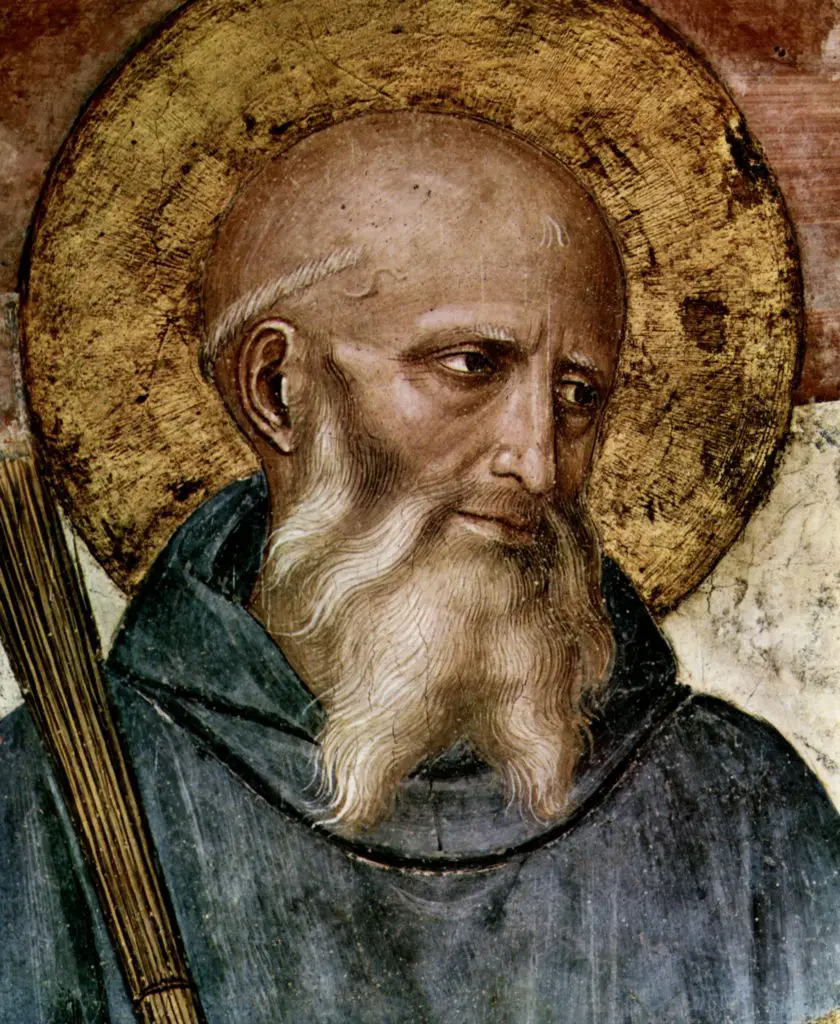
St Benedict’s sister, St Sholastica (480-543AD) established a convent of Nuns.
St Gregory the Great (540-604AD) recalls an incident where some of the Monks wanted to continue living wicked lives and found it difficult to conform to the rigorous life and rule of St Benedict, so they attempted to poison Benedict.
Upon blessing the cup where the poison had been place, it shattered. Hence why there is a cup featured on the medal.
A further incident of hatred towards the Holy Man Benedict is recounted, another attempt was made on his life by placing a piece of bread dipped in poison. However, Benedict detected this poison and asked a Raven to dispose of it and the Raven obeyed.
Once again this is the reason why there is a Raven on the Medal.These two incidents show the warding off Evil intentions and the Evil one himself.
What are the origins of the St Benedict Medal?
The Cross is a symbol and badge of the faith in Jesus Christ. St Benedict had a deep faith in the Cross and worked miracles with the sign of the cross. This has since passed down to the generations of Benedictines as a special devotion to the Cross.
This devotion to the Cross gave rise to the striking of the medal that bore the image of St. Benedict holding a cross aloft in his right hand and his rule for the Monasteries in the other hand.
Therefore, the Cross has always been closely associated with the Medal of St. Benedict, which is often referred to as the Medal-Cross of St. Benedict.
Over the course of time several additions were made.
The first St Benedict Medal is unknown, For a long time, the meaning of the letters around the medal were unknown until the discovery of a manuscript that dates back to 1415 in 1647 at the Abbey of Metten in Bavaria.
The Jubilee Medal of Monte Cassino
The above features were finally incorporated in a newly designed medal struck in 1880 under the supervision of the monks of Monte Cassino, Italy, to mark the 1400th anniversary of the birth of St. Benedict.
The design of this medal was produced at St. Martin’s Archabbey, Beuron, Germany, at the request of the prior of Monte Cassino, the Very Reverend Boniface Krug OSB (1838-1909). Since that time, the Jubilee Medal of 1880 has proven to be more popular throughout the Christian world than any other medal ever struck to honor St. Benedict.
What is contained on the Jubilee Medal?
Face of the Medal
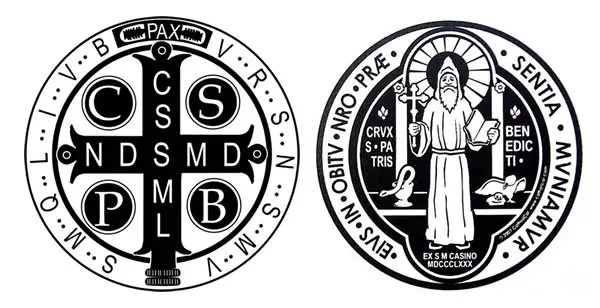
The image of St Benedict holding a Cross in his right and a Book symbolising the Monasteries’ Rule.
On a pedestal to the right of St Benedict is The Poisoned Cup as I explained earlier.
On a pedestal to the left is a Raven about to carry away a loaf of poisoned bread that a jealous enemy had sent to St. Benedict.
The letters are inscribed above the cup and Raven:
C. S. P. B. these are in Latin but translated to:
The Cross of our holy father Benedict
Encircling the figure of Benedict the Latin words as translated:
Latin: Eius in obitu nostro presentia muniamur
English: May we be strengthened by his presence in the hour of our death!
Below the feet of St Benedict are the Latin word as translated:
Latin: ex SM Casino MDCCCLXXX
English: from holy Monte Cassino 1880.
The place and date that commemorates the 1400-year anniversary of the birth of St Benedict.
The Reverse Side of the Medal
The Cross dominates the medal.
On the arms of the Cross are the initials:
C. S. S. M. L
Latin: Crux Sancta Sit Mihi Lux!
English: May the holy cross be my light!
May the dragon never be my guide!
In the angles of the cross, the letters:
C S P B
Latin: Crux Sancti Patris Benedicti
English: The cross of our holy father Benedict.
Above the Cross is the Latin:
Latin: PAX
English: Peace
Around the margin of the back of the medal, the letters:
V R S N S M V – S M Q L I V B
These letters stand for a Latin Prayer of Exorcism against Satan.
Latin: Vade retro Satana!
Nunquam suade mihi vana!
Sunt mala quae libas!
Ipse venena bibas!
English: Begone Satan!
Never tempt me with your vanities!
What you offer me is evil.
Drink the poison yourself!
How to use the Medal?
The Medal has no specific requirement only that it be validly blessed.
Worn on a chain – on A Rosary – next to your bed — in the car —-
The medal is a prayer of exorcism against Satan, whether to resist our own temptations, a prayer of peace and that the Cross be our light and guide and a prayer of firm rejection of all that is evil, a prayer of petition that we may with Christian courage “walk in God’s ways, with the Gospel as our guide and to carry our own cross on a daily basis,” as St. Benedict urges us.
The Approved Blessing
The Medals of Saint Benedict are sacramentals that may be blessed legitimately by any priest or deacon — not necessarily a Benedictine (Instr., 26 Sept. 1964; Can. 1168). The following English form may be used.
V. Our help is in the name of the Lord.
R. Who made heaven and earth.
In the name of God the Father + almighty, who made heaven and earth, the seas and all that is in them, I exorcise these medals against the power and attacks of the evil one. May all who use these medals devoutly be blessed with health of soul and body. In the name of the Father + almighty, of the Son + Jesus Christ our Lord, and of the Holy + Spirit the Paraclete, and in the love of the same Lord Jesus Christ who will come on the last day to judge the living and the dead, and the world by fire.
Amen.
Let us pray. Almighty God, the boundless source of all good things, we humbly ask that, through the intercession of Saint Benedict, you pour out your blessings + upon these medals. May those who use them devoutly and earnestly strive to perform good works be blessed by you with health of soul and body, the grace of a holy life, and remission of the temporal punishment due to sin.
May they also with the help of your merciful love, resist the temptation of the evil one and strive to exercise true charity and justice toward all, so that one day they may appear sinless and holy in your sight. This we ask though Christ our Lord.
Amen.
The medals are then sprinkled with holy water.
St Benedict, Pray for Us.
